Between ice cream and longer days, summer is here. At this time of year, open information can become our best ally to plan getaways, know schedules of the bathing areas in our community or even know the state of traffic on roads that take us to our next destination.
Whether you're on the move or at home resting, you can find a wide variety of datasets and apps on the datos.gob.es portal that can transform the way you live and enjoy the summer. In addition, if you want to take advantage of the summer season to train, we also have resources for you.
Training, rest or adventure, in this post, we offer you some of the resources that can be useful this summer.
An opportunity to learn: courses and cultural applications
Are you thinking of making a change in your professional career? Or would you like to improve in a discipline? Data science is one of the most in-demand skills for companies and artificial intelligence offers new opportunities every day to apply it in our day-to-day lives.
To understand both disciplines well and be up to date with their development, you can take advantage of the summer to train in programming, data visualization or even generative AI. In this post, which we published at the beginning of summer, you have a list of proposals, you are still in time to sign up for some!
If you already have some knowledge, we advise you to review our step-by-step exercises. In each of them you will find the code reproducible and fully documented, so you can replicate it at your own pace. In this infographic we show you several examples, divided by themes and level of difficulty. A practical way to test your technical skills and learn about innovative tools and technologies.
If instead of data science, you want to take advantage of it to gain more cultural knowledge, we also have options for you. First of all, we recommend this dataset on the cultural agenda of events in the Basque Country to discover festivals, concerts and other cultural activities. Another interesting dataset is that of tourist information offices in Tenerife where they will inform you how to plan cultural itineraries. And this application will accompany you on a tour of Castilla y León through a gamified map to identify tourist places of interest.
Plan your perfect getaway: datasets for tourism and vacations
Some of the open datasets you can find on datos.gob.es are the basis for creating applications that can be very useful for travel. We are talking, for example, about the dataset of campsites in Navarre that provides updated data on active tourism camps, including information on services, location and capacity. In this same autonomous community, this dataset on restaurants and cafeterias may be useful to you.
On the other hand, this dataset on the supply of tourist accommodation in Aragon presents a complete catalogue of hotels, inns and hostels classified by category, allowing travellers to make informed decisions according to their budget and preferences.
Another interesting resource is this dataset published by the National Institute of Statistics, which you can also find federated in datos.gob.es on trips, overnight stays, average duration and expenditure per trip. Thanks to this dataset, you can get an idea of how people travel and take it as a reference to plan your trip.
Enjoy the Water: Open Datasets for Water Activities
Access to information about beaches and bathing areas is essential for a safe and pleasant summer. The Bizkaia beach dataset provides detailed information on the characteristics of each beach, including available services, accessibility and water conditions. Similarly, this dataset of bathing areas in the Community of Madrid provides data on safe and controlled aquatic spaces in the region.
If you want a more general view, this application developed by the Ministry for Ecological Transition and Demographic Challenge (MITECO) with open data offers a national visualization of beaches at the national level. More recently, RTVE's data team has developed this Great Map of Spain's beaches that includes more than 3,500 destinations with specific information.
For lovers of water sports and sailing, tide prediction datasets for both Galicia and the Basque Country offer crucial information for planning activities at sea. This data allows boaters, surfers and fishermen to optimize their activities according to ocean conditions.
Smart mobility: datasets for hassle-free travel
It is not news that mobility during these months is even greater than in the rest of the year. Datasets on traffic conditions in Barcelona and the roads in Navarra provide real-time information that helps travellers avoid congestion and plan efficient routes. This information is especially valuable during periods of increased summer mobility, when roads experience a significant increase in traffic.
The applications that provide information on the price of fuel at the different Spanish petrol stations are among the most consulted on our portal throughout the year, but in summer their popularity skyrockets even more. They are interesting because they allow you to locate the service stations with the most competitive prices, optimizing the travel budget. This information can also be found in regularly updated datasets and is especially useful for long trips and route planning.
The future of open data in tourism
The convergence of open data, mobile technology and artificial intelligence is creating new opportunities to personalize and enhance the tourism experience. The datasets and resources available in datos.gob.es not only provide current information, but also serve as a basis for the development of innovative solutions that can anticipate needs, optimize resources, and create more satisfying experiences for travelers.
From route planning to selecting accommodations or finding cultural activities, these datasets and apps empower citizens and are a useful resource to maximize the enjoyment of this time of year. This summer, before you pack your bags, it's worth exploring the possibilities offered by open data.
The publication of open data is a practice that drives technological development, benefits the business sector, and informs citizens. However, there are still some institutions that do not publish their data in open format, either because they lack the means or the necessary guidance to do so.
To solve this problem, in a firm commitment to transparency and the reuse of public information, the Spanish Federation of Municipalities and Provinces (FEMP) has created a list that serves as a guide to take the first steps in open data that can also serve as a reference for the different local entities.. The idea is to complement the catalogues of published datasets and try to get at least these datasets published. The reason? As the FEMP points out, "the fact that all local administrations publish sets of data on a specific topic generates synergies and opportunities for products and services, which can be replicated in different entities".
In 2017, the FEMP published a first list of 20 recommended datasets, rising to 40 in 2019 and reaching the current 80 that were submitted in 2023.
The FEMP's 80 outstanding datasets can now be consulted on a website that gathers detailed information, and a document summarising the information. In this post, we analyse its content and recommendations.
Evolution of municipal open data engagement
Over the last few years, the Spanish Federation of Municipalities and Provinces has been expanding the list of open data to be published by local entities. This expansion reflects not only the increasing maturity of local administrations in their capacity to manage and publish data, but also the increasing demand by citizens, businesses and other social agents for useful and reusable information to develop services, research or simply to better understand their urban environment.
The 80 recommended datasets, covering almost all areas of local management, are presented, structured in categories that respond to the most relevant information needs of citizens:
-
Urban planning and public space
Among the priority data, it is recommended to publish information on general urban development plans, urban planning licences, technical inspection of buildings, street maps, cartographic representations of natural spaces, monuments and inventory of immovable property, etc.
-
Transport
This category refers to datasets about public transport, cycle lanes, public car parks (including those for people with reduced mobility), electric vehicle charging points, loading and unloading zones, traffic and accidents.
-
Environment
In this sector, the FEMP recommends publishing data on air and water quality, meteorological data, noise pollution, trees, parks and gardens, waste management, clean points, recycling containers, natural spaces and risk areas.
-
Public Sector
Here the publication of budget data, subsidies, procurement, average supplier payment period, public debt, regulations, transparency obligations and administrative procedures is recommended.
-
Demography and society
Data is collected on the municipal census, unemployment and employment, social aid, assistance services for people in need, census of associations and municipal facilities (educational, health, sports).
-
Tourism and culture
We found datasets on tourist accommodation, tourist flows, places of interest, cultural agenda and events.
The FEMP not only recommends what dataset to make available to citizens, but also offers guidance and good practices to carry out this task. Through the web, various information on each dataset is easily accessible:
- Your description.
- If available, recommended vocabularies to ensure interoperability.
- Whether they are high value sets (and the subcategory to which they belong).
- Recommended minimum refresh rate.
- File formats in which it is recommended to have the information.
- Examples of bodies that have already opened such a dataset, for reference.
- Some examples of visualisations that have been made with such open data.
- Etc.
Materials for data management and openness
To facilitate this opening-up process, local authorities have a number of resources at their disposal. Among others:
- The Standard Ordinance on Data Governance in the local entity, developed by the Open Data Group of the FEMP Network, which provides a common legal framework for the process of data openness and data management.
- Templates and guidance for the formulation of the RISP (Re-use of Public Sector Information) Plan, including key issues for developing an open data initiative.
- Guide for the deployment of data portals, a monographic report that compiles best practices and recommendations for developing and maintaining data portals in municipalities.
Challenges and next steps
Despite progress, the full implementation of these 80 datasets is a challenge for many municipalities, especially smaller ones, which may face technical or resource difficulties in publishing them.
Therefore, the continuous support of supra-municipal bodies such as provincial councils, autonomous communities and the FEMP itself is essential, as well as inter-municipal collaboration to share good practices, tools and technological solutions.
The extension to 80 priority datasets marks a milestone on the road to a data-driven governance model, where public information is transformed into a common good that generates value for both administrations and society as a whole.
We encourage you to consult the new project website and to progressively incorporate these datasets into your municipal portals, thus contributing to the construction of a more complete open data ecosystem, useful and transformative for our cities.
The Canary Islands Statistics Institute (ISTAC) has taken a significant step forward in the volume of geographic data thanks to the publication of a total of 4,002 new datasets (3,859 thematic maps and 143 statistical cubes) in datos.gob.es, following its federation in Canarias Datos Abiertos.
This type of initiative is aligned with the European Union's Data Strategy, which establishes the guidelines to achieve a single data market that benefits companies, researchers and public administrations. The automation of publication processes through common standards is key to ensure interoperability and adequate access to open data sets of public administrations.
The generation of these datasets is the culmination of an automation work that has allowed the expansion of the number of published cubes, as now combinations of granularity and year since 2004 are presented. In early October, the ISTAC added to its catalog more than 500 semantic assets and more than 2100 statistical cubes, as we told in this post on datos.gob.es.
In addition, the sets published to date have undergone a renewal process to become the aforementioned 143 statistical cubes. The increase of these datasets not only improves the directory of datos.canarias.es and datos.gob.es in quantitative terms, but also broadens the uses it offers thanks to the type of information added.
The indicators of these cubes are represented on the cartography through choropleth maps and in multiple formats. This automation will, in turn, not only allow other datasets to be published more easily in the future, but also more frequently.
Another of the advances of this work is that the services are generated on the fly from the Geoserver map server, and not through an upload to CKAN, as was done until now, which reduces their storage and speeds up their updating.
How to bring demographic indicators closer to the population
Demographic indicators are dense data cubes that offer a large amount of detailed geographic information, including total population, disaggregated by sex, residence, age and other indices up to a total of 27 different variables.
As so much information is contained in each cube, it can be difficult to represent specific indicators on the cartography, especially if the user is not used to working with certain GIS (Geographical Information System) software.
To bring this content to all types of users, the ISTAC has generated 3,859 new maps, representing on a choropleth map each of the indicators contained in the 143 statistical cubes. The publication of these new cartographic data is thus presented as a more efficient and simplified way of obtaining the information already represented, allowing users to easily access the specific data they need.
We could compare this transformation to flowers. Previously, only whole bouquets were published, with 27 flowers per bouquet, which had to be managed and handled to represent the flowers that were of interest. Now, in addition to continuing to publish the bouquets, new processes have been generated to be able to publish each flower separately, automating the generation of each of these sets, which will also be updated more frequently.
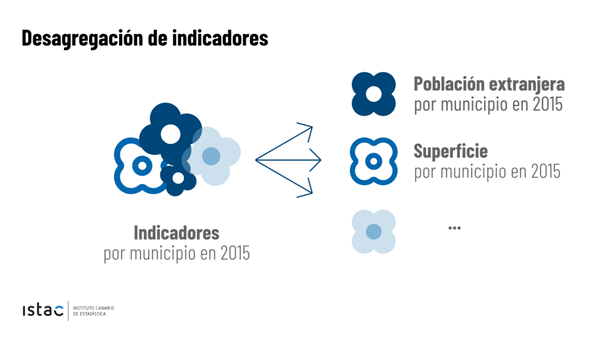
This new option facilitates the use of these choropleth maps (like the one shown in the image) by people without technical GIS knowledge, since they are presented in easily downloadable formats as images (.jpg and .png) for professional, educational or personal use.
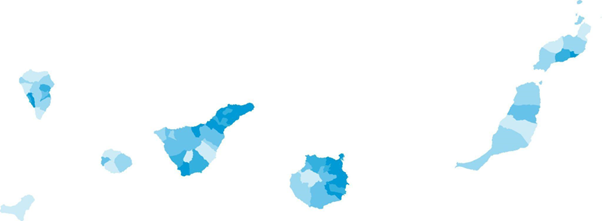

Mapa de población de 65 o más años (% sobre total) por municipios. Año 2022
For more advanced users, ISTAC has also expanded the range of formats in which the original indicator cubes are served. The "bouquets", which previously only showed data in CSV format, now have a wide variety of distributions: KML, GML, GeoPackage, GeoJSON, WFS, WMS. Taking advantage of the benefits provided by the use of styles in the WMS format, all the styles associated with the indicators have been generated, so that, using them, it is possible to represent the same map that is downloaded in image format. These styles are calculated for each indicator-granularity-year combination, according to the method of calculating quantiles for five intervals.
This new approach with both simple and complex geographic data enriches the catalog and allows users without specific knowledge to access and reuse them. In addition, it should be noted that this opens the door to other massive publications of data based on other statistical operations.
In short, this is an important step in the process of opening up data. A process that improves the use and sharing of data, both for the user on the ground and for professionals in the sector. Given the growing need to share, process and compare data, it is essential to implement processes that facilitate interoperability and appropriate access to open data. In this sense, the Canary Islands Institute of Statistics is concentrating its efforts to ensure that its open data sets are accessible and in the appropriate formats for sharing. All this in order to obtain value from them.
The digitalization in the public sector in Spain has also reached the judicial field. The first regulation to establish a legal framework in this regard was the reform that took place through Law 18/2011, of July 5th (LUTICAJ). Since then, there have been advances in the technological modernization of the Administration of Justice. Last year, the Council of Ministers approved a new legislative package to definitively address the digital transformation of the public justice service, the Digital Efficiency Bill.
This project incorporates various measures specifically aimed at promoting data-driven management, in line with the overall approach formulated through the so-called Data Manifesto promoted by the Data Office.
Once the decision to embrace data-driven management has been made, it must be approached taking into account the requirements and implications of Open Government, so that not only the possibilities for improvement in the internal management of judicial activity are strengthened, but also the possibilities for reuse of the information generated as a result of the development of said public service (RISP).
Open data: a premise for the digital transformation of justice
To address the challenge of the digital transformation of justice, data openness is a fundamental requirement. In this regard, open data requires conditions that allow their automated integration in the judicial field. First, an improvement in the accessibility conditions of the data sets must be carried out, which should be in interoperable and reusable formats. In fact, there is a need to promote an institutional model based on interoperability and the establishment of homogeneous conditions that, through standardization adapted to the singularities of the judicial field, facilitate their automated integration.
In order to deepen the synergy between open data and justice, the report prepared by expert Julián Valero identifies the keys to digital transformation in the judicial field, as well as a series of valuable open data sources in the sector.
If you want to learn more about the content of this report, you can watch the interview with its author.
Below, you can download the full report, the executive summary, and a summary presentation.
Data science has a key role to play in building a more equitable, fair and inclusive world. Open data related to justice and society can serve as the basis for the development of technological solutions that drive a legal system that is not only more transparent, but also more efficient, helping lawyers to do their work in a more agile and accurate way. This is what is known as LegalTech, and includes tools that make it possible to locate information in large volumes of legal texts, perform predictive analyses or resolve legal disputes easily, among other things.
In addition, this type of data drives the development of solutions aimed at responding to the great social challenges facing humanity, helping to promote the common good, such as the inclusion of certain groups, aid for refugees and people in conflict zones or the fight against gender-based violence.
When we talk about open data related to justice and society, we refer both to legal data and to other data that can have an impact on universalising access to basic services, achieving equity, ensuring that all people have the same opportunities for development and promoting collaboration between different social agents.
What types of data on justice and society can I find in datos.gob.es?
On our portal you can access a wide catalogue of data that is classified by different sectors. The Legislation and Justice category currently has more than 5,000 datasets of different types, including information related to criminal offences, appeals or victims of certain crimes, among others. For its part, the Society and Welfare category has more than 8,000 datasets, including, for example, lists of aid, associations or information on unemployment.
Of all these datasets, here are some examples of the most outstanding ones, together with the format in which you can consult them:
At state level
- Spanish Statistical Office (INE). Offences according to sex by Autonomous Communities and cities. CSV, XLSX, XLS, JSON, PC-Axis, HTML (landing page for data download)
- Spanish Statistical Office (INE). 2030 Agenda SDG - Population at risk of poverty or social exclusion: AROPE indicator. CSV, XLS, XLSX, HTML (landing page for data download)
- Spanish Statistical Office (INE). Internet use by demographic characteristics and frequency of use. CSV, XLSX, XLS, JSON, PC-Axis, HTML (landing page for data download)
- Spanish Statistical Office (INE). Average expenditure according to size of the municipality of residence. CSV, XLSX, XLS, JSON, PC-Axis, HTML (landing page for data download)
- Spanish Statistical Office (INE). Retirement age in access to Benefit. CSV, XLSX
- Ministry of Justice. Judicial Census. XLSX, PDF, HTML (landing page for data download
At Autonomous Community level
- Cantabrian Institute of Statistics. Statistics on annulments, separations and divorces. RDF-XML, XLS, JSON, ZIP, PC-Axis, HTML (landing page for data download).
- Basque Government. Standards and laws in force applicable in the Basque Country. JSON, JSON-P, XML, XLSX.
- Basque Government. Locating mass graves from the Civil War and Francoism. CSV, XLS, XML.
- Generalitat Catalana. Minstry of Justice resources statistics. XLSX, HTML (landing page for data download).
- Government of Catalonia. Youth justice statistics. XLSX, HTML (landing page de descarga de datos).
- Autonomous Community of Navarre. Statistics on Transfer of Property Rights. XLSX, HTML (landing page for data download).
- Principality of Asturias. Sustainable Development Goals indicators in Asturias. HTML, XLSX, ZIP.
- Principality of Asturias. Justice in Asturias: staffing levels of the judicial bodies of the Principality of Asturias according to type. HTML (landing page for data download).
- Cantabrian Institute of Statistics. Judges and magistrates active in the Canary Islands. HTML, JSON, PC-Axis.
A the local level
- Santa Cruz de Tenerife City Council. Parking spaces for people with reduced mobility. SHP, KML, KMZ, RDF-XML, CSV, JSON, XLS
- Madrid City Council. Justice Administration Offices in the city of Madrid. CSV, XML, RSS, RDF-XML, JSON, HTML (landing page for data download)
- Gijón City Council. Security forces. JSON, CSV, XLS, PDF, HTML, TSV, texto, XML, HTML (landing page for data download)
- Madrid City Council. Child and Family Care Centres. CSV, JSON, RDF-XML, XML, RSS, HTML (landing page for data download).
- Zaragoza City Council. List of police stations. CSV, JSON.
Some examples of re-use of justice and social good related data
In the companies and applications section of datos.gob.es you can find some examples of solutions developed with open data related to justice and social good. One example is Papelea, a company that provides answers to users' legal and administrative questions. To this end, it draws on public information such as administrative procedures of the main administrations, legal regulations, jurisprudence, etc. Another example is the ISEAK Foundation, which specialises in the evaluation of public policies on employment, inequality, inclusion and gender, using public data sources such as the National Institute of Statistics, Social Security, Eurostat and Opendata Euskadi.
Internationally, there are also examples of initiatives created to monitor procedural cases or improve the transparency of police services. In Europe, there is a boom in the creation of companies focused on legal technology that seek to improve the daily life of citizens, as well as initiatives that seek to use data for equity. Concrete examples of solutions in this area are miHub for asylum seekers and refugees in Cyprus, or Surviving in Brussels, a website for the homeless and people in need of access to services such as medical help, housing, job offers, legal help or financial advice.
Do you know of a company that uses this kind of data or an application that relies on it to contribute to the advancement of society? Then do not hesitate to leave us a comment with all the information or send us an email to dinamizacion@datos.gob.es.
This report published by the European Data Portal (EDP) covers the following topics.
Making data available as open data in all EU Member States is vital to harnessing its potential for European society and economy. In order to increase impact effectively, efforts must target the datasets that have the greatest potential in society and the economy.
In the regulation on open data and re-use of public sector information, the European Commission is mandated to adopt an implementing regulation specifying high-value datasets.
The line of argument developed in this report parallels what the Commission has done during the first quarter of 2021, to prepare the implementing regulation that includes a list of high-value datasets. This report reviews relevant literature, policy decisions and national initiatives to enable a deeper understanding of the situation around assessing the value of datasets.
The report is available at this link: "High-Value Datasets: Understanding the Data Providers' Perspective"
Who hasn't ever used an app to plan a romantic getaway, a weekend with friends or a family holiday? More and more digital platforms are emerging to help us calculate the best route, find the cheapest petrol station or make recommendations about hotels and restaurants according to our tastes and needs. Many of them have a common denominator, and that is that their operation is based on the use of data coming, for the most part, from public administrations.
It is becoming increasingly easy to find tourism-related data that have been published openly by various public bodies. Tourism is one of the sectors that generates the most revenue in Spain year after year. Therefore, it is not surprising that many organisations choose to open tourism data in exchange for attracting a greater number of visitors to the different areas of our country.
Below, we take a look at some of the datasets on tourism that you can find in the National Catalogue of Open Data in order to reuse them to develop new applications or services that offer improvements in this field.
These are the types of data on tourism that you can find in datos.gob.es
In our portal you can access a wide catalogue of data that is classified by different sectors. The Tourism category currently has 2,600 datasets of different types, including statistics, financial aid, points of interest, accommodation prices, etc.
Of all these datasets, here are some of the most important ones together with the format in which you can consult them:
At the state level
- National Statistics Institute (Ministry of Economic Affairs and Digital Transformation). Average stay, by type of accommodation by Autonomous Communities and Autonomous Cities. CSV, XLSX, XLS, HTML, JSON, PC-Axis.
- State Meteorological Agency (AEMET). Forecast by municipality, 7 days. XML.
- Geological and Mining Institute of Spain (Ministry of Science and Innovation). Spanish Inventory of Places of Geological Interest (IELIG). HTML, JSON, KMZ, XML.
- National Statistics Institute (Ministry of Economic Affairs and Digital Transformation). Rural Tourism Accommodation Price Index (RTAPI): national general index and by tariffs. CSV, HTML, JSON, PC-Axis, CSV
- National Statistics Institute (Ministry of Economic Affairs and Digital Transformation). Holiday Dwellings Price Index (HDPI): national general index and by tariffs. CSV, HTML, JSON, PC-Axis, CSV
- National Statistical Institute (Ministry of Economic Affairs and Digital Transformation). Tourist Campsite Price Index (TCPI): national general index and by tariffs. CSV, HTML, JSON, PC-Axis
At the level of the Autonomous Regions
- Regional Government of Andalusia. Andalusia Tourism Situation Survey. CSV, HTML
- Autonomous Community of the Basque Country. Tourist destinations in the Basque Country: towns, counties, routes, walks and experiences. RSS, API, XLSX, GeoJSON, XML, JSON, KML.
- Autonomous Community of Navarre. Signposting Camino Santiago. CSV, HTML, JSON, ODS, TSV, XLSX, XML.
- Autonomous Community of the Canary Islands. Active Tourism Activities registered in the General Tourism Register. XLS, CSV.
- Autonomous Community of Navarra. Ornithological tourism. CSV, HTML, JSON, ODS, TSV, XLSX, XML.
- Autonomous Community of Aragon. Footpaths of Aragon. XML, JSON, CSV, XLS.
- Cantabrian Institute of Statistics. Directory of Collective Tourist Accommodation (ALOJATUR) of the Canary Islands. JSON, XML, ZIP, CSV.
At the local level
- Valencia City Council. Tourist monuments. CSV, GML, JSON, KML, KMZ, OCTET-STREAM, WFS, WMS.
- Lorca City Council. Itineraries of tourist routes in the city centre. KMZ.
- Almendralejo Town Hall. Restaurants and bars of Almendralejo. XML, TSV, CSV, JSON, XLSX.
- Madrid City Council. Tourist offices of Madrid. HTML, RDF-XML, RSS, XML, CSV, JSON.
- Vigo City Council. Urban Tourism. CSV, JSON, KML, ZIP, XLS, CSV.
Some examples of re-use of tourism-related data
As we indicated at the beginning of this article, the opening up of data by public administrations facilitates the creation of applications and platforms that, by reusing this information, offer a quality service to citizens, improving the experience of travellers, for example, by providing updated information of interest. This is the case of Playas de Mallorca, which informs its users about the state of the island's beaches in real time, or Castilla y León Gurú, a tourist assistant for Telegram, with information about restaurants, monuments, tourist offices, etc. We can also find applications that make saving money easier (Geogasolineras) or that help people with disabilities to get around the destination (Ruta Accesible - How to get there in a wheelchair).
Public administrations can also take advantage of this information to get to know tourists better. For example, Madrid en Bici, thanks to the data provided by the city's portal, is able to draw up an X-ray of the real use of bicycles in the capital. This makes it possible to make decisions related to this service.
In our impact section, in addition to applications, you can also find numerous companies related to the tourism sector that use public data to offer and improve their services. This is the case of Smartvel or Bloowatch.
Do you know of any company that uses tourism data or an application based on it? Then don't hesitate to leave us a comment with all the information or send us an email to contacto@datos.gob.es. We will be happy to read it!
Open data can be very useful in promoting aspects such as the health and well-being of citizens or the protection of the environment, as well as the growth of economies. The opening of information encourages innovation, the creation and adaptation of companies and organizations around services and technologies capable of generating profitability and offering solutions to current problems from the reuse of data.
But, in addition, economic data contributes to many organizations being able to make better decisions. Economic statistics and indicators allow us to know how a certain market or country evolves, discover trends and act accordingly.
If you are interested in accessing this type of data, below, we collect 10 examples of repositories related to the economy at an international level:
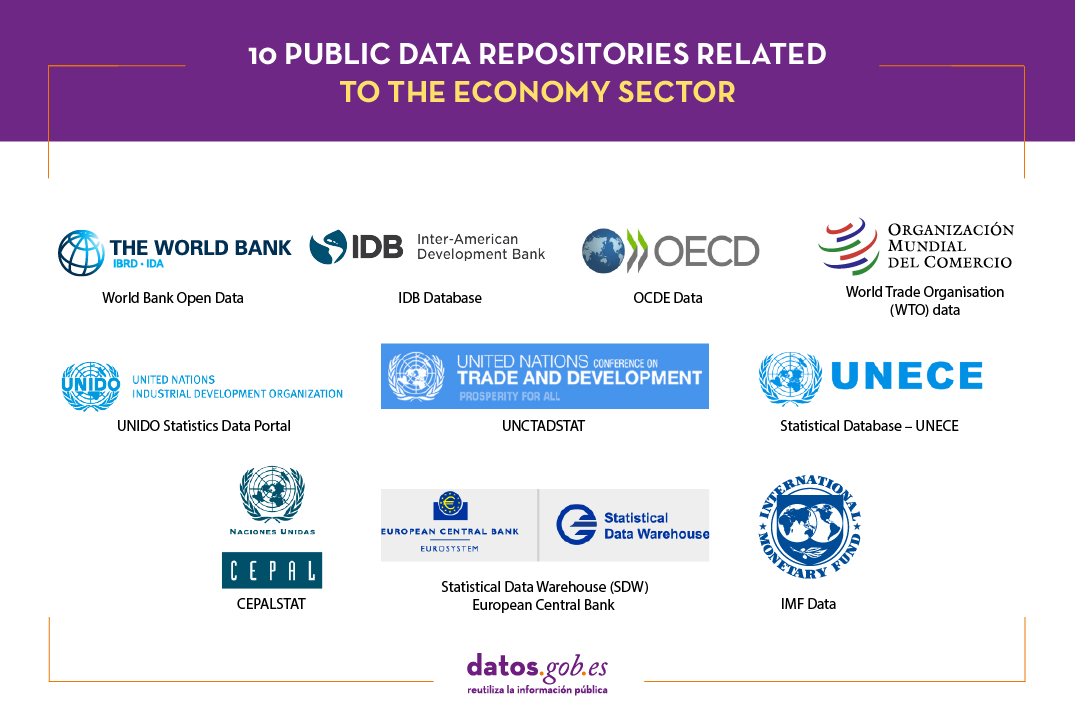
-
Publisher: World Bank
This is a website belonging to the World Bank. This platform offers a complete range of economic data that are frequently updated and allows access to open information produced by the World Bank itself. Among the type of data it offers are international debt statistics, world development indicators or databases on household consumption patterns around the world, among many others.
Two interesting sections stand out. One is its data catalog, where you can find information on economic topics such as statistical performance indicators or data on COVID-19, for example. Another is its microdata section, which offers a collection of datasets from the World Bank and other international, regional and national organizations.
Much of this data are offered in the most popular formats (HTML, JSON, PDF, CSV, ...). In addition, it has a space for reusers, with information on APIs.
-
Publisher: IMF (Internationaly Monetary Fund)
This portal contains IMF datasets on global financial stability, regional economics, global financial statistics, economic outlook, and more. Data can be downloaded in various formats, including XLSX and XLS.
-
Publisher: OECD (Organisation for Economic Co-operation and Development)
The OECD data catalog has a classification by sector, including the economic sector. It offers the possibility of filtering data according to whether or not they have access to the API. In addition, this portal allows queries to be made on large databases in its OECD.Stat data warehouse.
Particularly interesting are its data visualizations, such as these developed to show information about global employment rates, as well as other employment-related indicators.
-
Publisher: UNECE (United Nations Economic Commission for Europe)
On its public information portal, you can find various datasets, mostly economic, linked to the different countries of Europe. It also offers other datasets on population and transport and some alternative resources such as visualizations or data maps.
The data is displayed in four different forms: graphs, rankings, tables and maps. In this example, information about the global youth unemployment rate can be queried through the 4 means mentioned above. The data can be downloaded in CSV, TSV or JSON.
-
Publisher: Economic Commission for Latin America and the Caribbean (CEPAL, United Nations).
This portal brings together databases and statistical publications, as well as economic datasets for Latin America and the Caribbean, often accompanied by other resources such as data visualizations or maps. It also provides access to these data through an API to speed up and facilitate the data search process for its users. Data can be downloaded in XML, JSON or XLXS.
-
Publisher: ECB (European Central Bank)
The ECB, in collaboration with the national central banks and other national (statistical and supervisory) authorities of the European Union, offers a service for the development, collection, compilation and dissemination of statistics in open format.
The Statistical Data Warehouse provides indicators for the euro area, including in some cases national level breakdowns. Each of the statistics offered on this portal has a brief introductory description of the topics covered. All data are available for download in Excel and CSV format.
-
Publisher: World Trade Organisation (WTO).
The World Trade Organisation (WTO) is an international organisation that deals with the rules governing trade between countries. Its main objective is to help producers of goods and services, exporters and importers to conduct their activities in an optimal way.
The organisation offers access to a selection of relevant databases providing statistics and information on different trade-related measures. This information is classified in four main blocks: goods, services, intellectual property, statistics and other topics, making it easier for users to search for data.
On this page you can consult the WTO online systems (databases/websites) that are active. Some of them require registration.
UNIDO Statistics Data Portal
-
Publisher: United Nations Industrial Development Organization (UNIDO).
UNIDO is a specialised agency of the United Nations that promotes industrial development for poverty reduction, inclusive globalisation and environmental sustainability.
It publishes, among other things, datasets on industrial development, manufacturing production and investment. On its website, it has a search engine for information on indicators such as population growth or GDP growth by country. These data can be visualised through a graph that is updated with the selected information, also offering the possibility of comparing data from different countries within the same graph.
By accessing the DataBase section, each dataset can be downloaded in excel and CSV format.
UNCTADSTAT
-
Publisher: UNCTAD (United Nations Conference on Trade and Development)
UNCTAD is an organisation charged with helping developing countries harness international trade, investment, financial resources and technology to achieve sustainable and inclusive development.
On its open data portal, it collects statistical series by country and product, with a special focus on countries with developing and transition economies. Digital economy, international trade in services, maritime transport or inflation and exchange rates are just some of the topics that can be consulted on this platform.
In addition, for users who are not used to navigating this type of portal, UNCTAD provides a series of video tutorials that introduce the user to the data centre and show, among other things, how to export information from the platform (downloadable in CSV or XLSX).
-
Publisher: IDB (Inter-American Development Bank)
The Inter-American Development Bank (IDB) is an inter-national financial organisation whose main objective is to finance viable economic, social and institutional development projects and promote trade integration in Latin America and the Caribbean.
In its data section, it offers country development indicators related to the macroeconomic profile, global integration and social prospects of each country. Moreover, in this section you can find some additional resources such as graphs and visualisations that allow you to filter the information according to different indicators or courses to increase your economic knowledge based on the data.
Most of the data can be downloaded in CSV, JSON or RDF.
This has been just a small selection of data repositories related to the economic sector that may be of interest to you. Do you know of any other relevant repositories related to this field? Leave us a comment or send us an email to dinamizacion@datos.gob.es
Open data is fundamental in the field of science. Open data facilitates scientific collaboration and enriches research by giving it greater depth. Thanks to this type of data, we can learn more about our environment and carry out more accurate analyses to support decisions.
In addition to the resources included in general data portals, we can find an increasing number of open data banks focused on specific areas of the natural sciences and the environment. In this article we bring you 10 of them.

NASA Open Data Portal
- Publisher: NASA
The data.nasa.gov portal centralizes NASA's open geospatial data generated from its rich history of planetary, lunar and terrestrial missions. It has nearly 20,000 unique monthly users and more than 40,000 datasets. A small percentage of these datasets are hosted directly on data.nasa.gov, but in most cases metadata and links to other space agency projects are provided.
data.nasa.gov includes a wide range of subject matter, from data related to rocket testing to geologic maps of Mars. The data are offered in multiple formats, depending on each publisher.
The site is part of the Open Innovation Sites project, along with api.nasa.gov, a space for sharing information about NASA APIs, and code.nasa.gov, where NASA's open source projects are collected.
Copernicus
- Publisher: Copernicus
COPERNICUS is the Earth observation program of the European Union. Led by the European Commission, with the collaboration of the member states and various European agencies and organizations, it collects, stores, combines and analyzes data obtained through satellite observation and in situ sensor systems on land, air and sea.
It provides data through 6 services: emergency, security, marine monitoring, land monitoring, climate change and atmospheric monitoring. The two main access points to Copernicus satellite data are managed by ESA: the Copernicus Open Access Platform - which has an API - and the CSCDA (Copernicus Space Component Data Access). Other access points to Copernicus satellite data are managed by Eumetsat.
Climate Data Online
- Publisher: NOAA (National Centers for Environmental Information)
Climate Data Online (CDO) from the US government agency NOAA provides free access to historical weather and climate data worldwide. Specifically, 26,000 datasets are offered, including daily, monthly, seasonal and annual measurements of parameters such as temperature, precipitation or wind, among others. Most of the data can be downloaded in CSV format.
To access the information, users can use, among other functionalities, a search tool, an API or a map viewer where a wide variety of data can be displayed in the same visualization environment, allowing variables to be related to specific locations.
AlphaFold Protein Structure Database
- Publisher: DeepMind and EMBL-EBI
AlphaFold is an artificial intelligence system developed by the company DeepMind that predicts the 3D structure of a protein from its amino acid sequence. In collaboration with the EMBL European Bioinformatics Institute (EMBL-EBI), DeepMind has created this database that provides the scientific community with free access to these predictions.
The first version covers the human proteome and the proteomes of other key organisms, but the idea is to continue to expand the database to cover a large proportion of all cataloged proteins (over 100 million). The data can be downloaded in mmCIF or PDB format, which are widely accepted by 3D structure visualization programs such as PyMOL and Chimera.
Free GIS DATA
- Publisher: Robin Wilson, expert in the GIS area.
Free GIS Data is the effort of Robin Wilson, a freelance expert in remote sensing, GIS, data science and Python. Here users can find a categorized list of links to over 500 websites offering freely available geographic datasets, all ready to be loaded into a Geographic Information System. You can find data on climate, hydrology, ecology, natural disasters, mineral resources, oil and gas, transportation and communications, or land use, among many other categories.
Users can contribute new datasets by sending them by email to robin@rtwilson.com.
GBIF (Global Biodiversity Information Facility)
- Publisher: GBIF
GBIF is an intergovernmental initiative formed by countries and international organizations that collaborate to advance free and open access to biodiversity data. Through its nodes, participating countries provide data on species records based on common standards and open source tools. In Spain, the national node is GBIF-ES, sponsored by the Spanish Ministry of Science and Innovation and managed by the Spanish National Research Council (CSIC).
The data it offers comes from many sources, from specimens held in museums and collected in the 18th and 19th centuries to geotagged photos taken with smartphones and shared by amateur naturalists. It currently has more than 1.8 billion records and 63,000 datasets of great utility for researchers conducting studies related to biodiversity and the general public. You can also access its API here.
EDI Data Portal
- Publisher:Environmental Data Initiative (EDI)
The Environmental Data Initiative (EDI) promotes the preservation and reuse of environmental data, supporting researchers to archive and publish publicly funded research data. This is done following FAIR principles and using the Ecological Metadata Language (EML) standard.
The EDI data portal contains the contributed environmental and ecological data packages, which can be accessed through a search engine or API. Users should contact the data provider before using the data in any research. These data should be properly cited when used in a publication. A Digital Object Identifier (DOI) is provided for this purpose.
PANGAEA
- Publisher: World Data Center PANGEA
The PANGAEA information system functions as an open access library for archiving, publishing and distributing georeferenced Earth system research data.
Any user can upload data related to the natural sciences. PANGAEA has a team of editors who are responsible for checking the integrity and consistency of the data and metadata. It currently includes more than 400,000 datasets from more than 650 projects. The formats in which they are available are varied: you can find from text/ASCII or tab-delimited files, to binary objects (e.g. seismic data and models, among others) or other formats following ISO standards (such as images or movies).
re3data
- Publisher: DataCite
Re3data is a worldwide registry of research data repositories covering databases from different academic disciplines available free of charge. It includes data related to the natural sciences, medicine or engineering, as well as those linked to humanities areas.
It currently offers detailed descriptions of more than 2,600 repositories. These descriptions are based on the re3data metadata schema and can be accessed through the re3data API. In this Github repository you can find examples of how to use the re3data API. These examples are implemented in R using Jupyter Notebooks.
IRIS
- Publisher: Incorporated Research Institutions for Seismology (IRIS)
IRIS is a consortium of more than 100 U.S. universities dedicated to the operation of scientific facilities for the acquisition, management and distribution of seismological data. Through this website any citizen can access a variety of resources and data related to earthquakes occurring around the world.
It collects time series data, including sensor recordings of a variety of measurements. Among the metadata available is the location of the station from which the data was obtained and its instrumentation. It also provides access to historical seismic data, including scanned seismograms and other information from pre-digital sources.
Data are available in SEED (the international standard for the exchange of digital seismic data), ASCII or SAC (Seismic Analysis Code) format.
Do you know more international repositories with data related to natural sciences and environment? Leave us a comment or send us an email to dinamizacion@datos.gob.es.
Discover which are the strategic frameworks that mark the publication and use of open data, as well as the most outstanding datasets at local, regional, national and international level through the various infographics that we will publish periodically.
1. European Health Data Space: objectives and approach
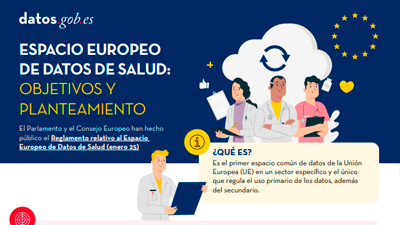 |
Published: February 2024 In this infographic we tell you the keys to the EU''s first common European data space in a specific sector and the only one that regulates primary, as well as secondary data use. Discover the areas of action, related projects and next steps. |
2. Data and its governance in the European Artificial Intelligence Regulation
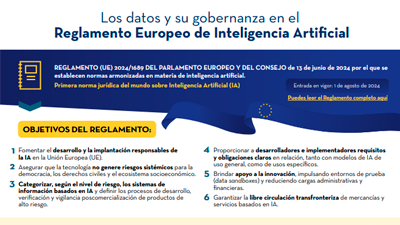 |
Published: October 2024 The European Regulation on Artificial Intelligence seeks to constitute a reference framework for the development of any system and to inspire codes of good practice, technical standards and certification schemes. In this infographic we tell you about its keys. |
3. Examples of open datasets published by local entities
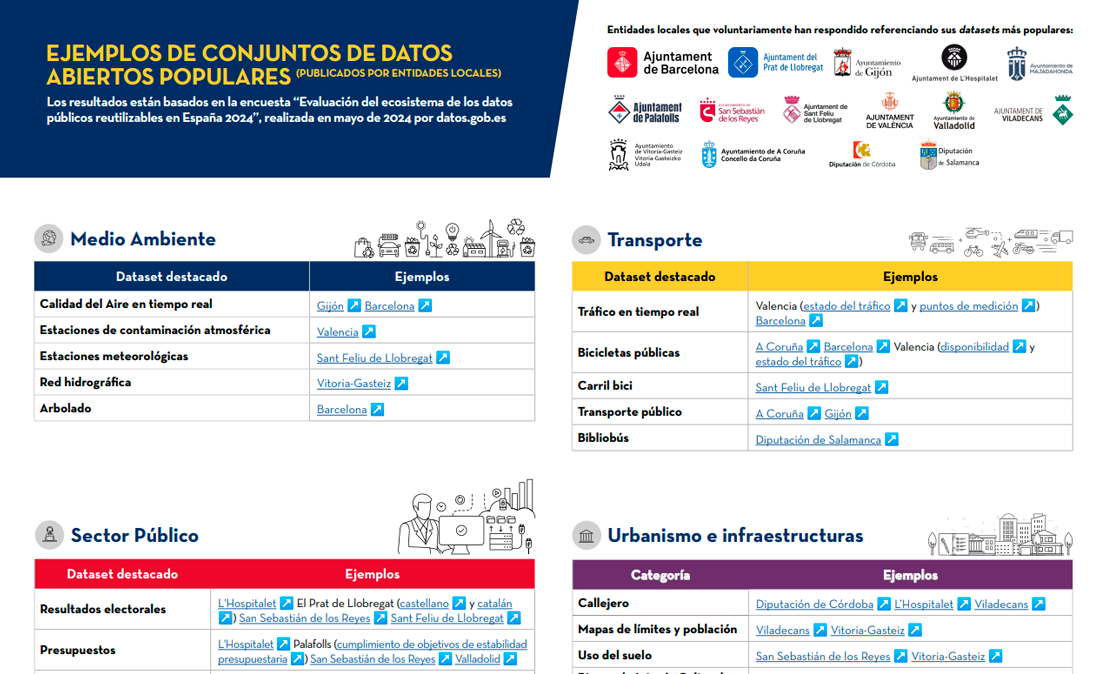 |
Published: September 2024 In order to learn about their open data activities, a survey was conducted last May in which representatives of local entities participated. This infographic collects examples of the most popular datasets from their portals. |
4. European Declaration on Digital Rights and Principles
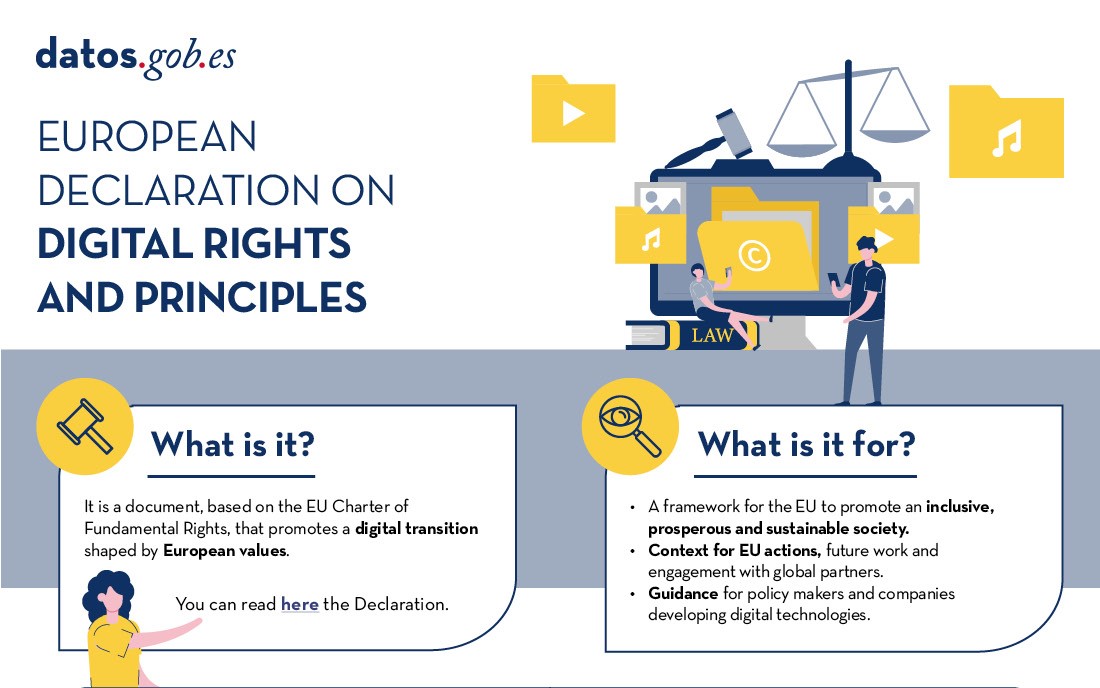 |
Published: August 2024 The Declaration is based on the EU Charter of Fundamental Rights, which promotes a digital transition shaped by European values. In this infographic, the principles that shape it and the opinion of European citizenship for each of them are presented. |
5. Artificial intelligence strategy 2024
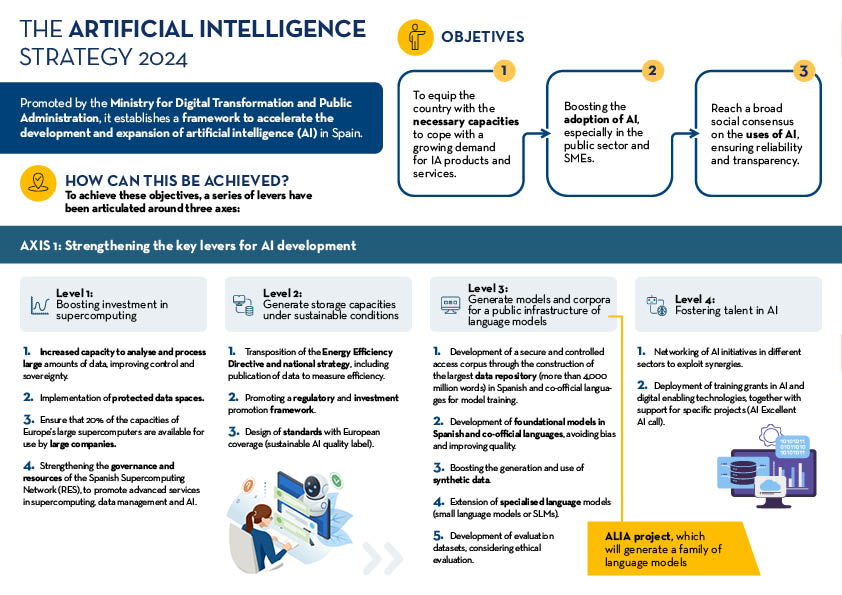 |
Published: July 2024 The new artificial intelligence strategy 2024 establishes a framework to accelerate the development and expansion of AI in Spain. It is articulated around three main axes developed through eight lines of action, which are detailed in this infographic. |
6.High value datasets
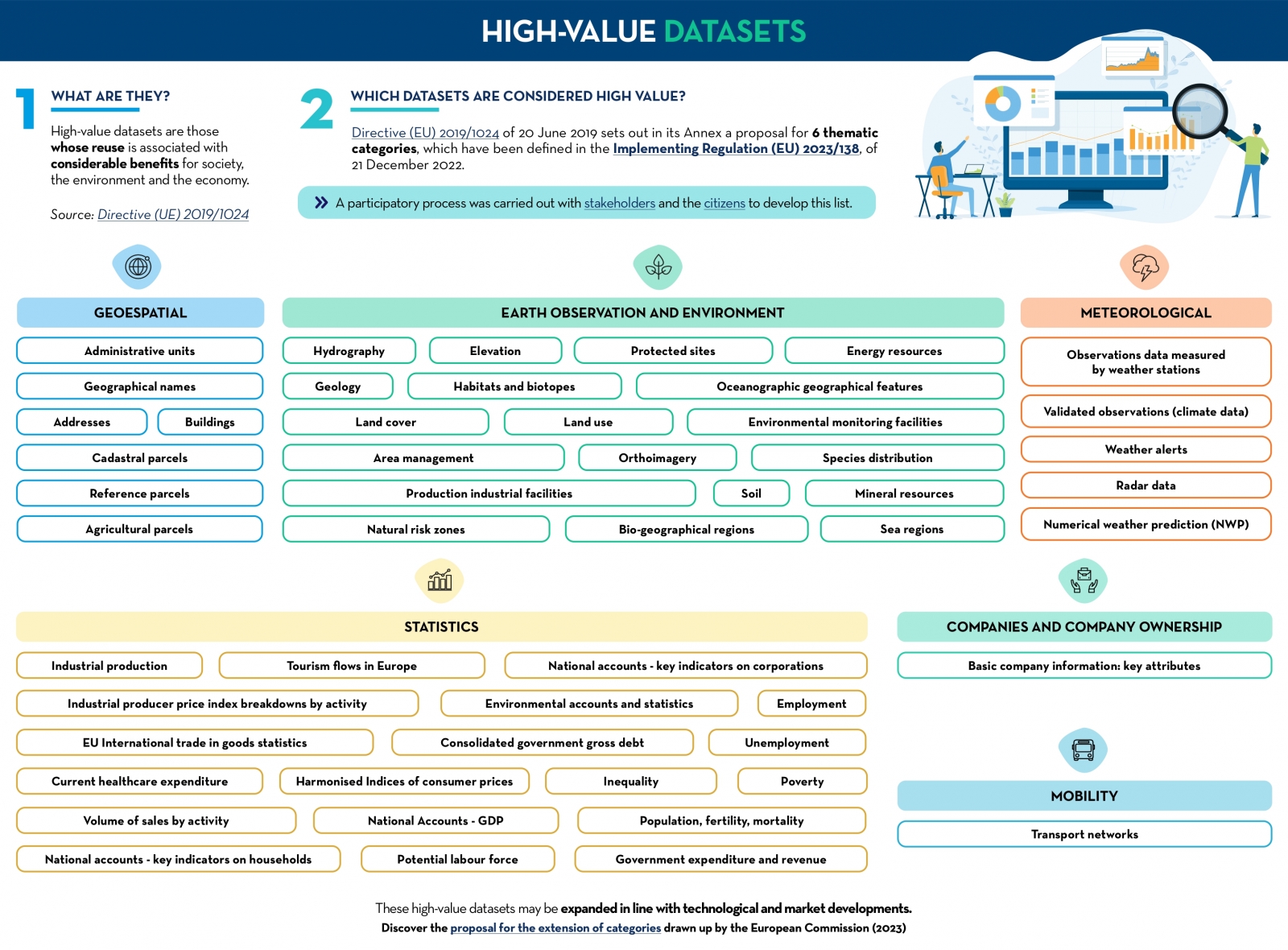 |
Published: March 2024 This infographic shows the high-value data categories defined in Implementing Regulation (EU) 2023/138 of 21 December 2022. Find out what these categories are and how the datasets linked to them should be published. A one-page version has also been created to facilitate printing: click here. |
7. Gaia-X and European data spaces
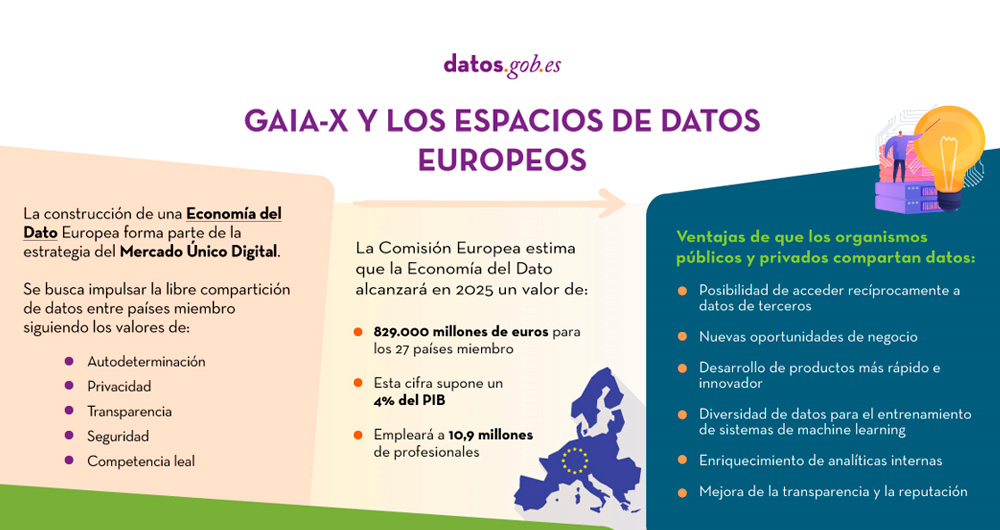 |
Published: April 2022 This infographic shows the context driving the development of data spaces, focusing on some related European initiatives such as Gaia-X and ISDA. |
8. Trends in open data around the world
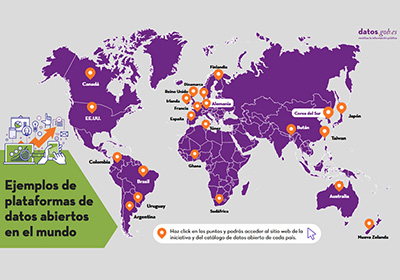 |
Published: Novembre 2021 Through this interactive infographic you can easily access the open data platforms and datasets of several leading countries. The infographic is accompanied by a post which briefly analyzes the strategies and next steps to be taken by these initiatives, showing what are the main trends worldwide. |
9. The most demanded datasets published by local entities
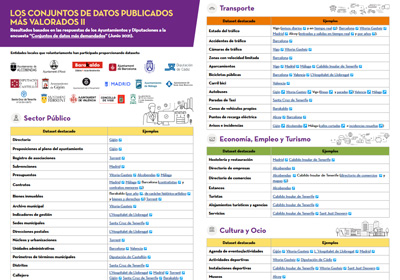 |
Published: July 2021 17 local entities, including city councils, provincial councils and an island council, share with the users of datos.gob.es which are their most demanded datasets, among all those published under standards that favour their reuse. The datasets are segmented by thematic categories, highlighting transport, environment and public sector data. |
10. The Open Government and Public Data Strategies of the Autonomous Communities
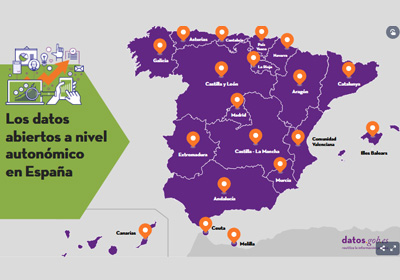 |
Published: June 2021 An interactive map shows the open data initiatives at regional level in Spain, including in each case the url to its portal and the main documents detailing its strategic framework. The infographic is accompanied by an article which addresses the commitments made by each Autonomous Region in the IV Open Government Plan of Spain. |
11. What are the most demanded datasets?
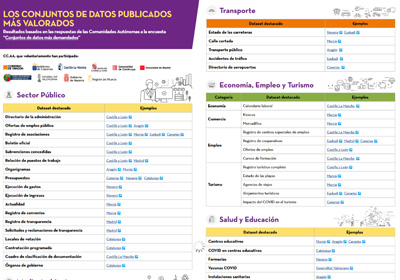 |
Published: May 2021 This infographic compiles some 100 datasets published by regional organizations, which are offered in open format according to standards that facilitate their reuse. The datasets are shown divided by thematic categories, highlighting those related to the public sector, the economy, employment and tourism, and the environment. |
12. The data-related strategies that will mark 2021
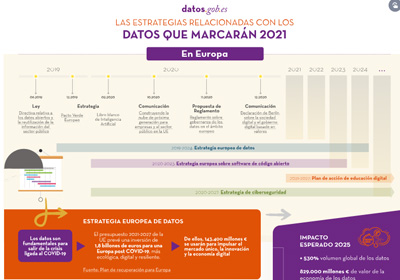 |
Published: January 2021 This interactive infographic shows the strategic, regulatory and political situation affecting the world of open data in Spain and Europe. It includes the main points of the European Data Strategy, the Regulation on Data Governance in Europe or the Spain Digital 2025 plan, among others. |